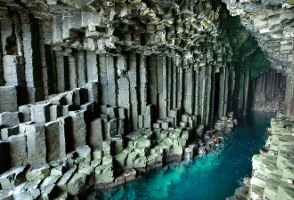 When thinking of nature-inspired classical music, pieces inspired by flowers, rivers, trees, birds, seasons, and beautiful scenery definitely fit the bill. You may think of everything from Vivaldi’s The Four Seasons to Beethoven’s Symphony No. 6 “Pastoral”. But how about a piece about a cave?
When thinking of nature-inspired classical music, pieces inspired by flowers, rivers, trees, birds, seasons, and beautiful scenery definitely fit the bill. You may think of everything from Vivaldi’s The Four Seasons to Beethoven’s Symphony No. 6 “Pastoral”. But how about a piece about a cave?
Yes, there is at least one classical piece about a cave and it’s a mysterious, dramatic, and beautifully melodic work. It’s everything you’d expect from a piece about a stunning yet lonely cave surrounded by the ocean. It’s Mendelssohn’s Hebrides Overture which we performed live on May 5, 2017.
Learn more about this fascinating overture. Here are 9 interesting facts you should know about The Hebrides.
1. It has had several titles. When Mendelssohn completed the work in 1830, it was originally titled Die einsame Insel or The Lonely Island. He revised the score 2 years later and, at that time, renamed the work Die Hebriden (The Hebrides). It was published in 1833 with the “Hebrides” title on various orchestral parts and Fingal’s Cave on the score.
2. It was inspired by a trip to the real cave. Mendelssohn visited England in 1829 and after touring the country, proceeded to Scotland. He and his friend, Karl Klingemann, traveled to the Hebrides Island off the west coast of Scotland and later to Fingal’s Cave, a real cave on the island of Staffa. The sea cave is known for its natural acoustics which project the rumbling of the waves inside for miles. Mendelssohn tried to capture the phenomenon in his overture. The cave is also known for its hexagonal basalt columns similar to those you can find at the Giant’s Causeway in Northern Ireland.
3. It is not a traditional overture. Many overtures serve as the opening to an opera or ballet, but The Hebrides represents a new type of overture called the “concert overture”, intended to stand as a complete work. Also, unlike some pieces, it does not tell a story, but rather depicts a mood and “sets a scene”. That also makes it an early example of a musical tone poem.
4. Mendelssohn was seasick on his trip to Fingal’s Cave. The composer and his friend took a skiff to Staffa to view the cave and sat at the mouth of the awe-inspiring formation. Mendelssohn was terribly seasick during the trip, but enjoyed it nonetheless. His friend, Klingemann, wrote that he got “along better with the sea as an artist than as a human being with a stomach.”
 5. The overture didn’t come easily. Mendelssohn apparently came up with the opening phrase of the overture while on his tour of Scotland. He sent it home on a postcard with a note to his sister Fanny that read, “In order to make you understand how extraordinarily the Hebrides affected me, I send you the following, which came into my head there.” Unfortunately, despite this stroke of genius, he completed at least 2 versions of the piece and wrote to his sister that he was still wrestling with it in 1832 because it did not savor enough of “oil and seagulls and dead fish”.
5. The overture didn’t come easily. Mendelssohn apparently came up with the opening phrase of the overture while on his tour of Scotland. He sent it home on a postcard with a note to his sister Fanny that read, “In order to make you understand how extraordinarily the Hebrides affected me, I send you the following, which came into my head there.” Unfortunately, despite this stroke of genius, he completed at least 2 versions of the piece and wrote to his sister that he was still wrestling with it in 1832 because it did not savor enough of “oil and seagulls and dead fish”.
6. It was dedicated to King Frederick William IV of Prussia. He was the Crown Prince of Prussia at the time and Mendelssohn’s patron.
7. The final autograph manuscript still exists. It is held at the Bodleian Library in Oxford. Its 34 pages are full of deletions and revisions in a fine calligraphy that was characteristic of Mendelssohn.
8. It consists of two distinct themes. The opening notes state the theme Mendelssohn conceived while visiting the cave and is played by violas, cellos, and bassoons. It sets an initial scene of haunting solitude until the violins take over and the lower voices begin a pattern of sixteenth notes that represent the ebb and flow of the sea. The second theme is a soaring melody meant to convey the drama of the scene. It was once called “the greatest melody Mendelssohn ever wrote” by musicologist Sir Donald Francis Tovey. There are also recognizable crescendos and crashes that represent the often stormy tides of the area.
9. A theory claims that first draft was completed on a very important cave-related date. Scottish writer Iain Thornber pointed out that the initial draft of The Hebrides was completed on the only day of the year the cave is illuminated by the sun. The cave is only fully illuminated when the sun lies 5.6 degrees above the horizon which is generally on or about December 16. Mendelssohn completed the draft on December 16, 1830. Either this was on purpose or it’s a big coincidence.




